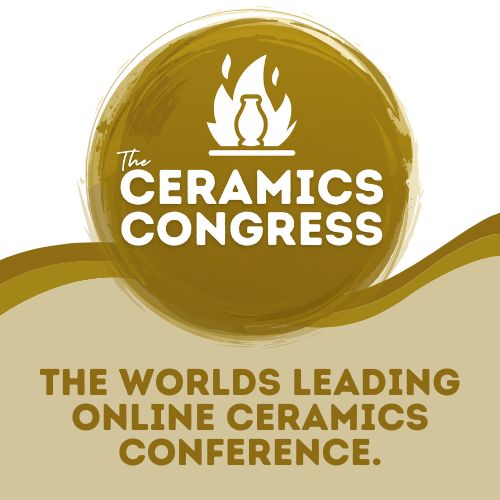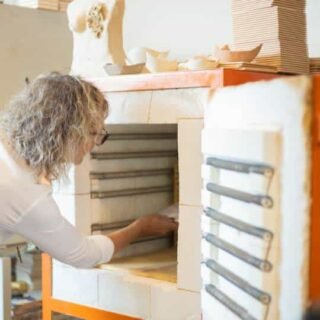
As a potter, you pour your heart and soul into your creations, and your artist statement is an excellent way to convey that same inspiration and passion to the world!
An artist statement is a document that communicates your artistic vision, ideas, and techniques to customers, sponsors, grant officials, galleries — and just about anyone who can help influence your clay career in a positive way. It is essential for establishing your identity as an artist and defining your place in the ceramic arts community.
Writing an artist statement can be daunting, but with a few guidelines, you can create a stunning and effective statement that resonates with your audience. So, we’ve put together some of our top tips for crafting an excellent artist statement as a potter, to help you when it comes to exhibiting your most important work: yourself!
Give Yourself Time to Write
Chances are you won’t feel satisfied with your first draft. Finding the perfect words to describe what makes your work unique and valuable is no easy feat.
One of the best things you can do is start drafting your artist statement right away, so that you have time to reflect on it and edit. Even if your first version is just bullet points of things you’d like to include, write them down sooner than later to get the creative writing juices flowing. It’s also a good idea to take time between each draft so that you can review what you’ve written with fresh eyes.
See What’s Been Successful
It’s hard to know how to write an artist statement if you’ve never read one!
Take time to look at the statements of artists you admire. If you are writing your statement for a specific purpose, such as having your work exhibited in a particular gallery or magazine, then pay attention to the trends in the artist statements of people who have already been featured there. You shouldn’t copy anyone, but you may notice a pattern of themes that you can highlight in your own statement.
Use the Right Voice and Word Count
Artist statements come from the artists themselves. So, unlike a biography, they are written in the first person (I, me, myself).
This also means that, while still professional, they have a more conversational feel. Consider how you would explain your art to another person if you were talking to them face-to-face. Your statement is a unique opportunity for you to connect with a reader in your own voice.
They are also meant to be brief. If you are writing your statement for a particular purpose, such as an exhibit, you may be given a specific word limit. If you don’t have other guidelines, a good length is about 150-250 words.
Communicating everything about your career in clay is not possible in just a few paragraphs. Instead, you should focus on the most relevant things that will be the most interesting or engaging for your audience.
Write for Your Audience
Your artist statement isn’t for you, it’s for your readers — so you’ll want to ensure that it resonates the right way with the people who read it.
Use clear, concise language and avoid technical jargon that could confuse or alienate readers. And never be afraid to rewrite your artist statement for a specific occasion! You should always customize the content of your artist statement depending on where it will be displayed.
For instance, your artist statement could be different for different series of your work. Or you could have a unique statement that accompanies your functional ware versus the one you use for sculpture. Focus on whichever part of your artistic approach is the most relevant to the situation at hand.
Try Using This Format
Here’s a great template for building a brand new artist statement from scratch!
- Personal Introduction
- Artistic Vision
- Inspiration and Emotions
- Conclusion
Let’s break down what each section is for…
Start With a Personal Summary
The opening lines of your artist statement should introduce you as a potter and set the stage for the reader.
Provide some context about your background, training, and any significant artistic influences that inform your work. Let them know what areas you focus on, such as the types of clay you specialize in, or whether you produce primarily sculpture or functional ware.
Describe Your Artistic Vision
Next, delve into your artistic vision and describe your creative process.
Explain how you approach your work and what inspires you. Discuss your techniques, materials, and any unique approaches you take to your craft. Share the challenges you’ve faced and how you’ve overcome them.
Share Your Passion
When you share your work with others, it’s easy for them to experience the final product. But it’s not always so easy for them to see the passion and ideas behind it.
Share the emotions and experiences that inspire you and fuel your creative energy. Discuss how your work reflects your values and beliefs, and how you hope to impact your audience.
Wrap Things Up Nicely
Summarize your artist statement and reiterate your artistic vision and goals with a short conclusion
Let your audience know what you want them to feel from your work, and what the benefit for them will be when they experience your art. You can also thank them for sharing in your creativity.
Example:
As a potter with 15 years of experience creating functional art, my work is a reflection of my deep connection to the landscapes of my home. Growing up in the Pacific Northwest, I was surrounded by lush forests and a rugged coastline, and those vistas continue to inspire me today.
My creative process involves a delicate balance between control and letting go. I start with a raw clay form, which I shape and refine using a combination of hand-building and wheel-throwing techniques. I then bisque-fire the pieces to prepare them for glazing, which is where the real magic happens.
I use a variety of glazing techniques, including layering and dripping, to create unique patterns and textures on the surface of my pots. Then, I load them into the kiln and let the flames work their transformative magic. The result is a vibrant and organic surface that reflects the unpredictability and beauty of nature.
For me, pottery is not just about creating beautiful objects, but also about cultivating a deeper appreciation for the natural world. Through my work, I hope to inspire others to connect with their environment and find beauty in the imperfections of life.
In conclusion, my passion for pottery is rooted in my connection to the natural environment I grew up in, and my artistic vision is to create pieces that reflect what that connection means to me. Whether you’re a collector or simply someone who appreciates the beauty of handmade objects, I hope that my work speaks to you and inspires you to see the world in a new light.
Edit, Edit, Edit
Once you’ve written your artist statement, it’s essential to review and edit it carefully. You should also update it regularly to ensure it matches the current tone of your work.
Pay attention to grammar, spelling, and punctuation, and ensure that you are saying what you want to say in as clear a way as possible. We also highly suggest having someone else (or multiple people) review your statement and provide feedback. There’s no better way to know what readers will think than to get some people to read it!
With a well-crafted artist statement, you can elevate your work and establish yourself as a serious and dedicated artist. And with our helpful tips, writing YOUR statement just got even easier!
Feel like you’re ready to write your own stunning artist statement? Why not use it to start promoting your work in our ever-growing Artist Directory! Click the link to see how you can register for free and make it possible for collectors and community members to discover your work: https://ceramic.school/join-directory/






Responses